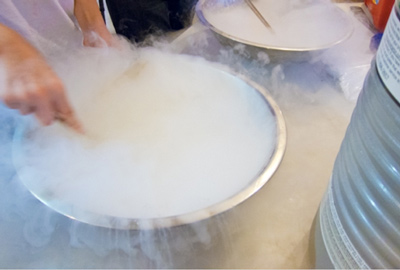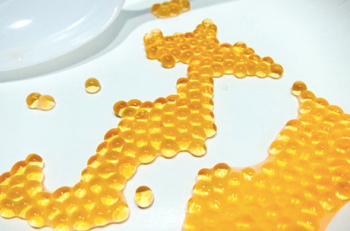 By Susan Lutz
By Susan Lutz
I’ve never really understood the lure of molecular gastronomy. I’ll admit that the science behind it is fascinating, but as food it just never rocked my world. While dining on cotton candy foie gras at a restaurant known for molecular gastronomy, I ordered an Old-Fashioned. By the time I’d swallowed the chemically engineered “cherry” at the bottom of the drink, I’d had a brainstorm. This experience would be a lot more fun if the chef would simply sit beside me and explain why the seemingly solid maraschino cherry magically disappeared in my mouth. In fact, I wanted to know everything about the scientific principals that made crazy concoctions like this possible.
Unfortunately I’d never found a way to make this happen. That is, until I attended the 2nd Annual Liquid Nitrogen Ice Cream Social at LA Makerspace in Los Angeles. It was really less of an ice cream social and more of a molecular gastronomy magic show. This event answered my question about the maraschino cherry, plus a few I’d never thought to ask.
Related: Getting to know the reality of how elBulli operated.
The mastermind behind the event was Ariel Levi Simons. He’s a passionate amateur molecular gastronomist, as well as a physics teacher at Wildwood School in West Los Angeles and a founding member of LA Makerspace. In front of a group of about 50 people, Simons created culinary illusions, while simultaneously explaining the science behind the magic. Families with small children helped him freeze ice cream in less than 30 seconds under a cloud of bubbling liquid nitrogen. Grown-up science geeks mulled the question of which tasted better, carbonated pineapple or fizzy habañero-infused avocado.

I was most excited to learn aboutspherification, the process by which my faux-maraschino cherry was created. Simons enthusiastically described a magical elixir that could turn almost any liquid into a sphere. It’s all thanks to sodium alginate, a common food additive derived from kelp that many of us eat every day. It’s used to prevent freezer burn in ice cream and thicken McDonald’s apple pies. Simons makes a slightly more upscale concoction: synthetic caviar.
Simons loads equal amounts of a concentrated syrup, such as Torani, and sodium alginate into a syringe. Then he squeezes small drops of the mixture into a solution of food-grade calcium chloride. When the two solutions meet, the calcium ions bind to the sodium alginate, forming a skin around the liquid that magically transforms into a sphere within a few seconds.
Related: Check out Simons’s technique using syringe with Torani syrup and sodium alginate.
It’s pure physics and chemistry. When you bite into these tiny spheres, the thin skin immediately bursts, unleashing the taste of tangerine or black tea inside. It’s not quite caviar, but the mystery of the faux-maraschino was solved.

The greater mystery of the event turned out to be Simons himself. I was surprised to learn that Simons’ interest in food chemistry runs deeper than the simple parlor tricks of molecular gastronomy, which he describes as “the showiest and quickest” way to talk about food chemistry.
Simons is passionate about traditional methods of food preservation, as I am, and we discussed real magic: the slow but startling fermentation ofkimchi, the alchemy of 1,000-year-old eggs, and the mysterious transformation of black garlic. Simons is fascinated with the chemistry of even the most basic foods. He revealed the fact that corn syrup is far more chemically complex than anything he made at the ice cream social. In fact, the production of corn syrup is so complex that it is only economically feasible because the United States government subsidizes the production of corn, which makes it almost free as a raw product.
Simons thinks the complexity of our food actually may be a problem, especially because no one realizes how ubiquitous it is. “Food production has been a driving force in human history,” he said. And sadly, this driving force has largely been forgotten.
“We don’t think about food production because we don’t have to,” he said. “We’ve sort of won the game.”
Related: TV shows the laboratory behind the kitchen.
But Simons recognizes that there are good reasons to understand where our food comes from and how it’s made. The point of Simons’ “magic show” at the ice cream social was to “show that it’s not actually magic. It’s a technique we developed to take food and transport it and sell it across the world.”
For me, the real thrill of molecular gastronomy is discovering the science behind the seemingly magical concoctions that I eat. I’ve tried my own food alchemy demonstrations with my kids, including making my own sugar from sugarcane. And when I next have the opportunity to taste potato foam gnocchi or dried olive soil, I won’t need the chef sitting next to me to fully enjoy the experience.
But frankly, my favorite form of molecular gastronomy involves the chemical reaction between a large bag of salt and the back leg of a pig. Country ham — now that’s magic.
Photos, from top:
Molecular gastronomy in action. Credit: Susan Lutz
Ariel Levi Simons shares a bowl of liquid nitrogen ice cream. Credit: Susan Lutz
Synthetic caviar in its final form. Credit: Susan Lutz
Zester Daily contributor Susan Lutz is a photographer, artist and television producer. A native of Virginia’s Shenandoah Valley, she currently lives in Los Angeles, where she is writing a book about heirloom foods and the American tradition of Sunday dinner.
source: http://www.huffingtonpost.com/zester-daily/the-magic-that-molecular-_b_3439778.html

Comments are closed